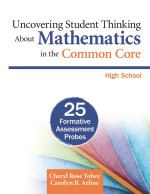The following checklist from Step into STEAM, Grades K-5, includes the crucial elements to incorporate into your STEAM PBL as you embark on a STEAM inquiry using a Problem-Based Learning (PBL) framework.
The following checklist from Step into STEAM, Grades K-5, includes the crucial elements to incorporate into your STEAM PBL as you embark on a STEAM inquiry using a Problem-Based Learning (PBL) framework.
This chapter from We Reason & We Prove for ALL Mathematics, "Setting the Stage," will help students engage in mathematical activities that emphasize reasoning, justifying, and proving.
Included in this excerpt from Teaching Mathematics in the Visible Learning Classroom, High School, is a Peer Assisted Review (PAR) activity on on understanding volume formulas. PARs are a great resource to help students reflect on their own thinking and solve meaningful problems.
This Peer-Assisted Reflection (PAR) activity from Teaching Mathematics in the Visible Learning Classroom, Grades 3-5, helps you develop strategies for process feedback, which is critical as learners explore the why and the how of specific mathematics content.
This checklist from Teaching Mathematics in the Visible Learning Classroom, Grades K-2, provides instruction on how to compose mathematics tests that truly assess mastery.
Learn how to design structured inquiry, guided inquiry, and open inquiry tasks on the topic of straight lines with this unit from Concept-Based Mathematics.
Using this lesson from The Common Core Mathematics Companion, 6-8, students analyze proportional relationships and use them to solve real-world and mathematical problems (Secondary).

Use this lesson from Uncovering Student Thinking About Mathematics in the Common Core, High School, on equivalent expressions to probe student understanding and misconceptions.

Use this lesson from Uncovering Student Thinking About Mathematics in the Common Core, Grades 6-8, on linear equations to probe student understanding and misconceptions.
Learn how to use this Matrix featured in Realizing Rigor to refine strategies and select student actions. (Secondary)
Students apply and extend previous understanding of multiplication and division to multiply and divide fractions using this lesson from The Common Core Mathematics Companion, 3-5. (Elementary)
Students extend their understanding of place value by bundling tens with this lesson from The Common Core Mathematics Companion, K-2. (Elementary)